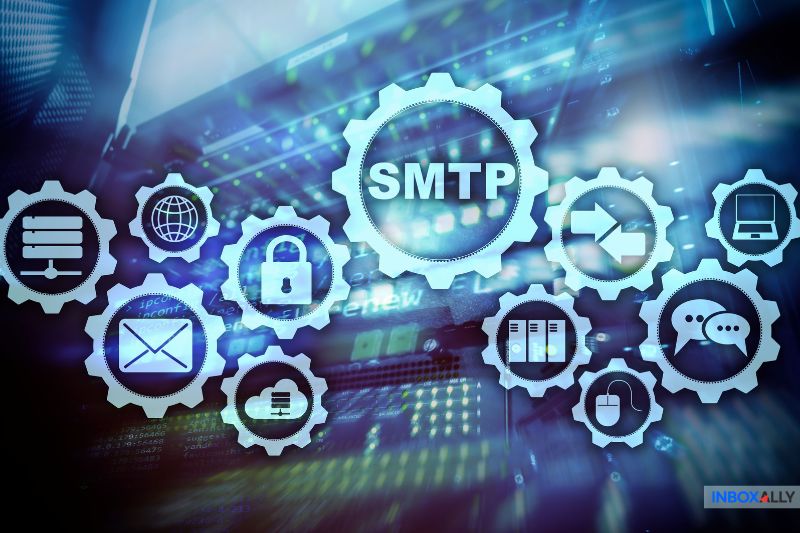Ever wondered what magic keeps your emails moving? You probably hit “send” without a second thought, but behind the scenes, two email protocols—SMTP and IMAP—are doing the legwork. But why should you care?
Well, if your emails vanish into thin air or arrive hours late, these protocols are usually to blame. SMTP’s job is simple—get your email from your outbox to the recipient’s receiving email server. IMAP, on the other hand, keeps your inbox in sync across all your devices.
In this article, you’ll learn how SMTP and IMAP hold your email system together and how understanding them can save you a lot of frustration when troubleshooting email issues. Let’s begin!
SMTP in Action – How Your Email Finds Its Way
When you hit send, your email client (Microsoft Outlook, Gmail, or otherwise) engages in a little back-and-forth with the SMTP server. It starts with a HELO command essentially saying, “Hey, I’ve got mail!” If the mail server is ready to process the message, it replies with a 250 OK response. Then, the email itself—headers, body, attachments—gets handed over, and once everything’s delivered, the server terminates the connection.
However, the process isn’t always smooth. Many providers block Port 25, the default SMTP port, due to its vulnerability to spam. Instead, modern email systems favor Port 587 to secure your email in transit. Some services also use Port 465 (SSL) or the less common Port 2525. Without secure ports, your email might get rejected or marked suspicious before it ever reaches the inbox.
SMTP does a lot more than just transfer emails—it helps with spam control and error handling, ensuring your messages reach the right inbox. You can read more about SMTPs here, but as you’ll find out below, they need the IMAP protocol to complete the cycle. So let’s talk a bit about that…
IMAP’s Role – Why It’s Built for Multi-Device Life
These days, we jump between laptops, phones, and tablets—and expect our emails to stay organized across all of them. IMAP (Internet Message Access Protocol) is the reason that it works. Unlike POP3 (Post Office Protocol version 3), which downloads and deletes emails from the server, IMAP stores everything remotely. This means your inbox looks the same no matter which device you’re using.
IMAP works by retrieving message headers first so you can see your inbox without downloading every email. When you open a message, it loads the full content on demand, keeping local storage use low. If you read, delete, or move an email on one device, those changes instantly reflect everywhere else.
Of course, security matters too. While IMAP’s default Port 143 is still around, most providers have moved to Port 993 with TLS/SSL encryption. Why? Because without it, your login credentials (and everything else) could be intercepted in transit. Not exactly ideal!
How Ports and Encryption Keep Emails Safe
Email is a favorite target for cyberattacks. Without proper security, sensitive data like login credentials, personal details, or even business information can be exposed. That’s why encryption and secure ports are so important.
For SMTP, Port 587 is the go-to. It uses STARTTLS encryption, making sure your email messages aren’t intercepted. On the retrieval side, IMAP typically operates on Port 993, which enables TLS/SSL encryption to protect your email access across multiple devices.
Older ports like 25 (SMTP) and 143 (IMAP) are not so great, though. No built-in encryption means attackers can easily intercept emails, which is why most providers either block or heavily restrict them.
Bottom line: secure ports and encryption aren’t just good to have—they’re non-negotiable if you want to keep your emails safe.
Your emails deserve to be seen. InboxAlly helps you regain control over your inbox placement by improving sender reputation and engagement. Start improving your deliverability today.
Do IMAP and SMTP Really Need Each Other?
Absolutely! SMTP and IMAP are a team—one sends, the other organizes. Without both, email wouldn’t work the way we expect it to.
Here’s how they split the job:
- SMTP (Simple Mail Transfer Protocol) handles the sending. When you hit send, SMTP delivers the message from your mail client to the recipient’s server.
- IMAP (Internet Message Access Protocol) takes over once the email reaches the inbox. It keeps everything synced across all devices, making sure emails stay organized and accessible.
Without SMTP, your emails would never leave your outbox. Without IMAP, you’d lose inbox sync across your phone, laptop, and tablet. Together, they make email smooth and seamless—something we rely on every day without even thinking about it.
How SMTP Handles Large-Scale Email Sending
Sending a couple of emails? Easy. Sending thousands—or even millions? That’s where you’ll need SMTP relays. These specialized servers keep high-volume email sending under control, handling queueing, retries, and delivery management so mail servers don’t get overwhelmed.
But sheer volume isn’t the only challenge. Bulk emails need to avoid spam filters, or they’ll never make it to an inbox. That’s why SMTP relays automatically apply authentication protocols like SPF, DKIM, and DMARC. They prove the sender is legitimate which boosts deliverability and keeps messages out of spam folders.
This isn’t just something small email clients need—massive enterprises and email marketing platforms rely on dedicated SMTP relay servers to send promotions, transactional emails, and account updates efficiently. Without mail relaying, large-scale email sending would be a logistical nightmare, riddled with bounces, delays, and spam flagging.
Struggling with emails landing in spam? Your sender reputation might be working against you. InboxAlly helps make sure your messages reach the inbox every time—see how it works.
SMTP Errors and IMAP Failures
Ever had an email bounce back with a confusing error message? SMTP protocol errors, like 550 Blocked, usually mean your email was flagged as spam—often due to missing SPF, DKIM, or DMARC records. SMTP servers take security seriously, so even legitimate emails can get caught if authentication isn’t set up properly.
IMAP issues, on the other hand, tend to show up when your inbox refuses to sync properly. Maybe your connection dropped mid-fetch, or you’re using an outdated port. If Port 143 (unencrypted) or Port 993 (TLS/SSL) isn’t behaving, your emails might not load correctly across devices.
Annoying? Yes. But these errors are also proof of how much effort goes into making sure email—used by billions every day—remains functional, secure, and spam-free.
Final Thoughts
By now, it’s clear—SMTP and IMAP are inseparable in keeping email communication smooth and reliable. Without one, the other would be incomplete, making modern email workflows chaotic at best. They work together behind the scenes to maintain the system we rely on daily.
So, the next time you send or check an email, you’ll have a deeper understanding of how these protocols quietly support the messages that keep your life—and business—running.
And if your emails are still getting stuck in spam, your sender reputation might be the culprit. Internet service providers (ISPs) watch how recipients interact with your emails, and if engagement is low, your messages are more likely to end up in junk.
That’s where InboxAlly can help:
- It sends positive signals to ISPs, showing that your emails belong in the inbox.
- It boosts engagement metrics, helping to establish a better sender reputation.
- It gives you visibility into what’s actually affecting your deliverability.
Want to take your email marketing ahead of the competition? See what InboxAlly can do for you!






